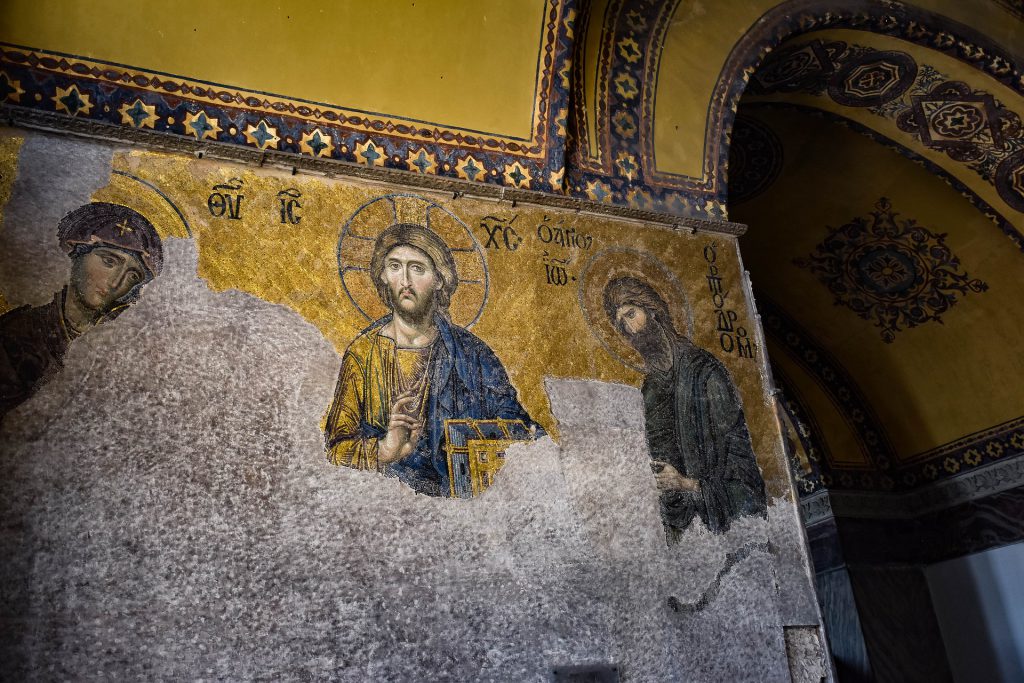Last month, Turkish President Recep Tayyip Erdogan made a decision that shocked the Christian and Orthodox world- he would be taking steps to reconfigure the Hagia Sophia back into an active mosque, after it had been a popular museum for some 85 years. Hagia Sophia has a rich history and is a religious and cultural symbol for Christians and Muslims alike. Initially constructed in the year 537, the Hagia Sophia served as a church three different churches over a span of 916 years (Church of Constantius II, Church of Theodosius II, and Church of Justinian 1) before it was converted to a mosque during the fall of Constantinople to the Ottoman forces in 1453. For the next 482, the Hagia Sophia served as a mosque and a notable gathering center for Muslims in the East.
In 1935, the Hagia Sophia officially was registered by President Atatürk as a museum for people of all religions, thus secularizing the building and allowing it to remain as a prominent symbol for both Muslims and Christians alike. In July 2020, after about two years of President Erdogan’s repeated promises to revert the Hagia Sophia into a mosque, the Council of Ministers made the decision to move forward with the reversion, and it has since been reopened as a mosque. Mixed reactions ensued- many Muslims cheered the decision, feeling that the Hagia Sophia was rightfully returned to them. However, the Christian community felt utterly betrayed, as the Hagia Sophia initially served as a church for almost a millennia prior to its service as a mosque.
Now, piggybacking on the extremely divisive and controversial July decision, President Erdogan once again has decided to turn an ancient Orthodox church and current museum- former Church of St. Saviour in Chora and currently the Kariye Museum- into a mosque. Erdogan’s recent decisions have raised concern throughout the world about the efficacy of religious tolerance in Turkey and the implications on religious liberty for years to come.
Church of St. Saviour in Chora, situated in Istanbul, originally served as a monastery building in the 4th century during the Byzantine empire, being rebuilt and re-decorated throughout the centuries and various transitions of power. The church has remained an icon throughout history and is noteworthy for its beautiful frescoes and mosaics. Sharing a similar history to the Hagia Sophia, during the fall of the Byzantine Empire and the rise to power of the Ottoman forces in the region, the Church was converted into an acting mosque by the name of Kariye Mosque. In 1945, it became Kariye Museum under presidential leadership, and it has since remained both a UN World Heritage Site as well as a religious symbol for Turkish and Middle Eastern Christians and Muslims alike.
Greek Orthodox Archbishop Elpidophoros of America tweeted his emotional response to the transition, stating “After the transgression with #HagiaSophia, now the Monastery of Chora, this exquisite offering of Byzantine culture to the world! The Turkish people do not deserve such a narrow-minded policy. The pleas and exhortations of the international community are ignored. How long?”
His Eminence Metropolitan Evangelos of New Jersey also responded:
“The Turkish government, after having illegally and unjustly claiming the Great Cathedral of Agia Sophia as their own for use as a mosque, has sought to continue their lawless and unconscionable actions by converting the Church of the Holy Savior in Chora to a mosque. Though it was readily apparent even before this most recent affront that the Turkish government will stop at nothing to advance their carefully crafted plans of religious and cultural genocide against Orthodox Christians and Greek culture, this latest abhorrent action proves to be nothing short of a vile assault against not just all Christians, but all people who treasure the principles of justice, peace, and religious freedom.”
Image by Bruno Heron Bruno Heron from Pixabay

